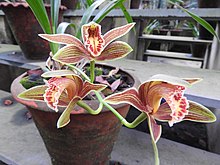
Back زورقان Arabic زورقان ARZ Cymbidium Byelorussian Цимбидиум Bulgarian Cymbidium Catalan Cymbidium CEB Cymbidium German Cymbidium Spanish Kymbidit Finnish Cymbidium French
| Boat orchids | |
|---|---|

| |
| Cymbidium iridioides | |
| Scientific classification | |
| Kingdom: | Plantae |
| Clade: | Tracheophytes |
| Clade: | Angiosperms |
| Clade: | Monocots |
| Order: | Asparagales |
| Family: | Orchidaceae |
| Subfamily: | Epidendroideae |
| Tribe: | Cymbidieae |
| Subtribe: | Cymbidiinae |
| Genus: | Cymbidium Swartz[1] |
| Type species | |
| Cymbidium aloifolium | |
| Species | |
|
See text. | |
| Synonyms | |
| |
Cymbidium /sɪmˈbɪdiəm/,[2] commonly known as boat orchids, is a genus of evergreen flowering plants in the orchid family Orchidaceae. Orchids in this genus are epiphytic, lithophytic, terrestrial or rarely leafless saprophytic herbs usually with pseudobulbs. There are usually between three and twelve leaves arranged in two ranks on each pseudobulb or shoot and lasting for several years. From one to a large number of flowers are arranged on an unbranched flowering stem arising from the base of the pseudobulb. The sepals and petals are all free from and similar to each other. The labellum is significantly different from the other petals and the sepals and has three lobes. There are about fifty-five species and sixteen further natural hybrids occurring in the wild from tropical and subtropical Asia to Australia. Cymbidiums are well known in horticulture and many cultivars have been developed. The genome of Cymbidium mannii has been sequenced to study epiphytism and crassulacean acid metabolism.[3]
- ^ "Cymbidium". World Checklist of Selected Plant Families (WCSP). Royal Botanic Gardens, Kew.
- ^ Sunset Western Garden Book, 1995:606–607
- ^ Fan, Weishu; He, Zheng-Shan; Zhe, Mengqing; Feng, Jing-Qiu; Zhang, Le; Huang, Yiwei; Liu, Fang; Huang, Jia-Lin; Ya, Ji-Dong; Zhang, Shi-Bao; Yang, Jun-Bo; Zhu, Andan; Li, De-Zhu (2023-09-11). "High-quality Cymbidium mannii genome and multifaceted regulation of crassulacean acid metabolism in epiphytes". Plant Communications. Focus Issue on Plant Single-Cell Biology. 4 (5): 100564. doi:10.1016/j.xplc.2023.100564. ISSN 2590-3462. PMC 10504564. PMID 36809882.
© MMXXIII Rich X Search. We shall prevail. All rights reserved. Rich X Search